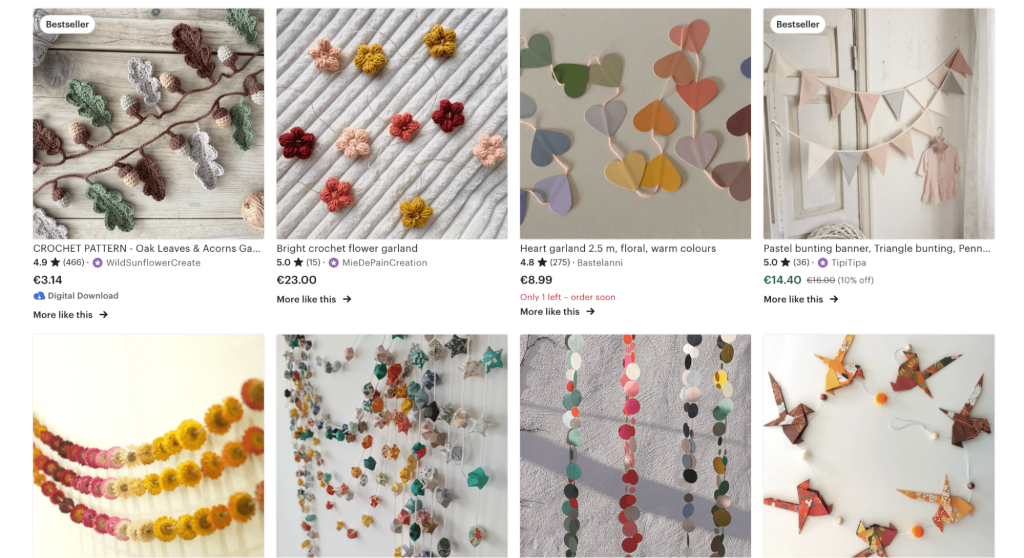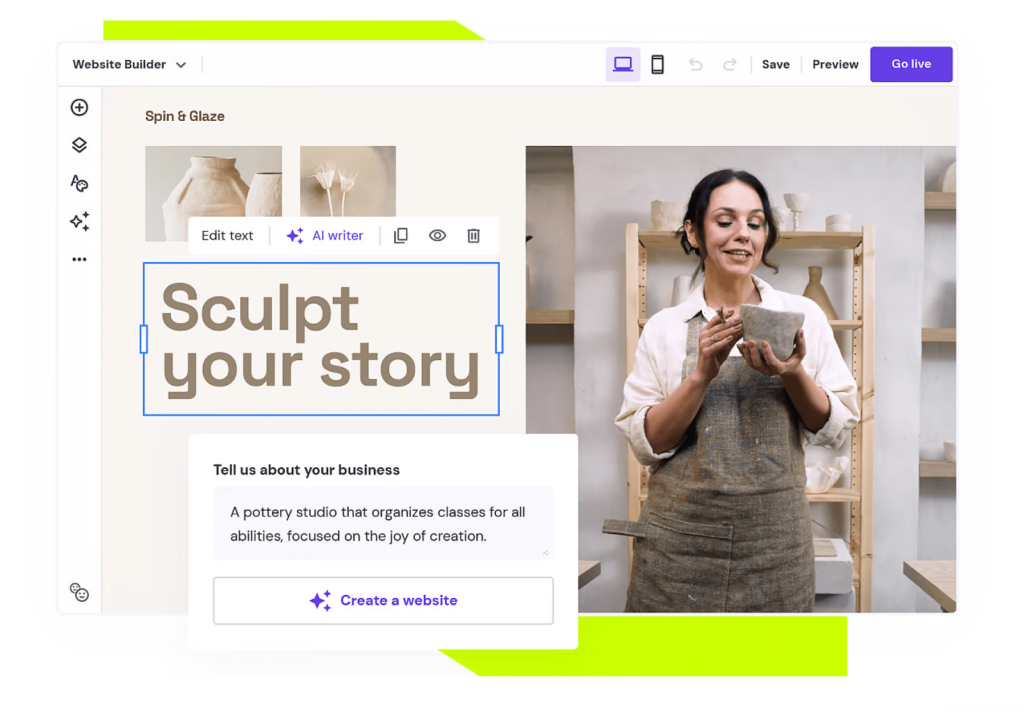How to start a craft business in 2025: Step-by-step guide

With more people seeking unique, handmade products, the craft industry offers huge potential for side hustlers and creative entrepreneurs.
Whether you want to earn extra income or eventually turn your passion into a full-time business, this guide will help you start a craft business in 2025.
We’ll explain everything you need to know to get started, from understanding the market to building a strong brand and scaling your business.
1. Conduct market research
Understanding the market you’re entering helps you avoid wasting time and money on products that might not sell. On top of this, market research gives you valuable insights on how to develop your creative business idea for success from the start.
Identify market demand
Knowing what’s in demand right now ensures you’re creating something people want to buy. Start by exploring platforms like Etsy, Pinterest, or Instagram. Search for similar products and pay attention to the following:
- Product listings. Look at how competitors present their products. Do any designs, materials, or themes stand out?
- Pricing. Note the pricing strategies competitors use. Any certain price points that seem to attract more buyers?
- Reviews. Read customer reviews to identify what buyers like and where they see room for improvement. This can give you a clear idea of what to focus on in your products.

You can also visit local craft fairs or pop-up markets to get direct feedback from potential customers. Ask them what types of products they’re drawn to and why.
This first-hand feedback is crucial because it helps you understand what buyers really want. It also helps you adjust your products to meet the buyers’ needs better and increase your chances of making sales.
Take a look at the recent eCommerce statistics to gain a deeper understanding of the latest industry trends.
Find a niche
Finding a niche will help you stand out in a competitive market. A niche isn’t just about making something different – it’s about aligning your passion with market needs. Here’s how to find yours:
- Reflect on your strengths. What do you love making the most? Whether it’s custom candles, handcrafted leather goods, or minimalist jewelry, focusing on your strengths can help you create standout products.
- Assess market gaps. While exploring Etsy or other marketplaces, pay attention to underserved categories or where you can improve on what’s already available.
- Test early. Start small by launching a few products and gauging interest before expanding your product line. You can use platforms like Etsy or even Instagram to test out ideas and get early feedback from your target audience.
Focusing on a niche helps you avoid spreading yourself too thin and increases your chances of connecting with a specific group of buyers who are more likely to purchase from you.
When researching what to sell, check out the most profitable craft ideas to sell for inspiration, as they’re trending among successful craft businesses.
2. Write a business plan
Once you’ve done your market research, it’s time to start putting together a solid business plan.
This might sound intimidating, but it doesn’t have to be. Think of your business plan as a roadmap that outlines where you’re headed and how you’re going to get there. It will guide your decisions and help attract investors if you ever decide to seek funding.

Key sections to include
Here are the main parts to focus on when drafting your craft business plan:
- Executive summary. A brief overview of your business idea, goals, and what makes your craft products unique.
- Product descriptions. Detail what you’ll be selling, including materials, design inspiration, and any unique features.
- Competitive analysis. Research your competitors and explain how your business stands out.
- Financial projections. Estimate your income, expenses, and potential profits over the next year or two. This helps you stay realistic about what you need to do to succeed.
Remember that a business plan isn’t just for big businesses – it’s essential for small side hustles, too. It provides structure and helps you stay on track as you grow. Plus, if you ever need to apply for funding, a clear business plan will show potential investors that you’re serious and organized.
If you’re creating your first business plan, our tutorial on how to start a business provides a helpful roadmap for new entrepreneurs.
Plan your financials
Having a good grasp of your finances is crucial, even if you’re starting small. Knowing where your money is going and how much you need to earn is key to staying profitable.
Track startup costs and profit margins
Begin by listing your initial costs, such as materials, tools, packaging, and marketing. For example, if you’re making handmade candles, include the cost of wax, wicks, containers, and labels. Once you know your costs, it’s time to figure out your pricing. A simple formula you can use is:
Cost of supplies x 2 = Wholesale price
Wholesale price x 2 = Retail price
This ensures you cover your expenses while making a profit. You can adjust these numbers based on your specific situation, but the goal is to price your products in a way that brings in profit while remaining competitive. Learn more in our detailed guide on how to price a product.
Funding options
If you need help covering startup costs, you have a few options.
Small business loans or crowdfunding are common routes for new businesses. Crowdfunding platforms like Kickstarter or GoFundMe let you raise funds by offering early versions of your products or other rewards to backers.
Alternatively, small business grants may be available depending on your location.
Understand legal requirements
Running a craft business means you’ll need to make sure you’re covered legally. This includes applying for any licenses or permits required by your local government, which may vary depending on the type of products you’re selling.
For example, if your craft involves food, skincare products, or candles, you might need additional permits for health and safety. Getting your paperwork in order from the start will help you avoid any headaches down the road.
It’s also a good idea to invest in business insurance. While it might not seem necessary at first, it can protect you from unexpected costs or liabilities – whether it’s a customer injury or product-related issue.
This extra layer of protection ensures that your personal finances won’t be impacted by any business-related challenges.
Pro tip
Not sure if you need a business license? Our guide on do I need a business license to sell online breaks down what’s required, depending on your location and products.
Choose a business name and business structure
Choosing the right business name is more important than you might think.
Your name will represent your brand, so make sure it’s memorable, unique, and aligned with your products. Before you settle on a name, check if it’s available as a domain for your website, as having the same name everywhere makes it easier for customers to find you online.
Domain Name Checker
Instantly check domain name availability.
Also, run a quick trademark search to avoid any legal issues later on.
When it comes to the legal structure of your business, you’ll need to decide what works best for you.
A sole proprietorship is the easiest and most common option for small craft businesses because it’s simple to set up. However, keep in mind that your personal assets aren’t protected if the business runs into legal trouble.
Alternatively, forming an LLC (Limited Liability Company) offers more protection for your personal finances but requires more paperwork and often costs more. Taking the time to choose the right structure will ensure you’re protected as your business grows.
3. Design and develop your products
With your market research and business plan in place, it’s time to focus on what really matters – your products.
This step involves crafting items that reflect your passion and meet the needs of your target customers. The goal is to develop a product line that fills gaps in the market while staying true to your brand.
Craft your product line
When designing your products, think back to the market research you conducted.
What are your customers looking for? Are there specific trends or preferences you can tap into?
By focusing on these needs, you’ll be able to create products that stand out and are more likely to sell.
Start by developing a core product line that’s manageable in terms of production and materials.
For instance, if you’re creating handmade jewelry, you might want to start with a few signature pieces that showcase your unique style. As you get feedback and see what resonates with customers, you can expand your product line based on demand.
To help you stay on track:
- Focus on quality. Ensure that your products are well-made, durable, and consistent. Customers who trust the quality of your products are more likely to return for another purchase.
- Keep it simple. When starting out, less is more. Launch with a small, focused collection and build gradually as you gather feedback and grow your business.
Regulations
Depending on the type of products you’re making, there may be regulations you need to follow.
For example, if you’re selling food items, cosmetics, or children’s products, you’ll need to comply with safety and health standards specific to your industry. Regulations can vary depending on your country or state, so make sure to research the local laws that apply to your craft.
It’s essential to get this right from the start. Following regulations not only protects your customers but also shields your business from potential legal issues. This can include labeling requirements, safety testing, or certifications for specific materials or ingredients you’re using.
4. Build your brand
Building a strong, recognizable brand helps you stand out and connect with your customers on a deeper level. A well-crafted brand identity is key to attracting the right audience and making a lasting impression.
To build your brand, start by defining its visual and emotional elements. These are the aspects that will shape how customers perceive your business. Here’s what to focus on:
- Logo. Your logo is often the first thing people see, so it should represent your style and the essence of your products. If design isn’t your strength, don’t worry – tools like Hostinger’s AI Logo Maker can help you create a professional logo without the need for a graphic designer.
- Color scheme. Choose a color palette that aligns with your brand’s personality. For example, earthy tones work well for natural, eco-friendly products, while vibrant colors might suit bold, modern designs. Stick to a few core colors to keep your brand consistent across all platforms.
- Tone of voice. This is how you communicate with your customers, both online and in person. Are you casual and friendly, or professional and elegant? Make sure your tone reflects the values of your brand and resonates with your target audience. For instance, a handmade soap business might use a calm, soothing tone, while a trendy jewelry shop could be more playful and energetic.
Creating a cohesive brand identity will help you establish a strong presence, whether you’re selling online, in stores, or at markets. It also makes your business more memorable and trustworthy.
5. Set up your online craft store
Choosing the right platform to sell your products is crucial for building a successful craft business.
While platforms like Etsy and Amazon Handmade are popular options, creating your own online store gives you complete control over the main elements of your store:
- Pricing. Most online marketplaces take a percentage of every sale and charge listing fees.
- Brand. It is very difficult to stand out in marketplaces, as your customers will be able to see your competitors very easily – most likely, even on the same screen.
- Customer experience. With your own website, you will have full control over your store’s interface and design.
That’s why Hostinger Website Builder stands out as a more profitable solution for side hustlers looking for a quick, simple, affordable way to launch an online store.

With Hostinger Website Builder, you can get your craft store up and running in one afternoon, even if you have no technical experience.
The platform is designed to be user-friendly, offering templates specifically tailored for small businesses and eCommerce, so you don’t have to worry about coding or complex setups. Plus, you’ll have access to AI-powered tools that make managing your store even easier.
Get started like this:
- Sign up for Hostinger Website Builder. Choose the Business plan to get eCommerce features and AI tools.
- Use AI to create a layout. Describe your store in a few words and answer a few questions, and the AI builder will create a site layout complete with placeholder content.
- Add your products. Add your items, upload images, set prices, and organize them into categories.
- Set up payment and shipping. Connect your chosen payment gateway, and configure shipping methods to fit your needs.
- Publish your store. Once everything looks good, click Publish and follow the on-screen instructions for connecting your domain name to your site.
For step-by-step guidance on building an online store, read how to make an online store with a website builder.
Once your store is live, it’s important to showcase your products in the best light. With the builder’s built-in AI tools, you can quickly create professional product listings that stand out. Here’s how:
- AI Writer for product descriptions. Craft engaging and keyword-rich descriptions in seconds, taking the guesswork out of copywriting.
- AI Image Generator. Create unique images based on text prompts directly within the editor.
- AI SEO Assistant. Optimize your store for search engines, making it easier for customers to find you online.
6. Market your craft business
Once your products are ready and your store is live, it’s time to spread the word.
Marketing plays a huge role in getting your craft business in front of the right customers. A strong marketing plan doesn’t have to be expensive or time-consuming, but it does need to be targeted and consistent.
Create a marketing plan
Start by identifying the best platforms to reach your target audience.
Social media is one of the most powerful tools for marketing craft products, especially on visual platforms like Instagram and Pinterest. Here are a few key strategies to include in your marketing plan:
- Social media marketing. Regularly post high-quality photos of your products on Instagram or Pinterest. Use hashtags, collaborate with influencers, and engage with your audience through comments and direct messages. The more active you are, the more visible your business becomes.
- Email marketing. Encourage customers to subscribe to your website or social media to build an email list. Send regular updates about new products, special offers, or behind-the-scenes content to keep your audience engaged.
- PPC (pay-per-click) ads. If you want to reach a larger audience quickly, PPC ads on platforms like Google or Facebook can be highly effective. Start with a small budget and target specific keywords or interests that align with your craft business. If your online store is built using Hostinger Website Builder, you can set up campaigns right from the dashboard thanks to the integrated Google Ads app.
- Blogging. Start a blog focused on crafting to attract organic traffic and boost your SEO. Share tips, how-to guides, and product ideas to engage your audience and drive more visitors to your site.
Consistency is key to any marketing strategy. Set aside a little time each week to work on your social media posts or email campaigns so your business stays top of mind for customers.
Engage your customers
Building a community around your brand is one of the best ways to create loyal customers.
Rather than just pushing sales, focus on interacting with your audience in meaningful ways. Share your creative process, post customer testimonials, and encourage followers to share their own photos or experiences with your products.
Platforms like Instagram and Pinterest are perfect for this.
On Instagram, you can engage with followers through Stories, Q&A sessions, or polls.
On the other hand, on Pinterest, you could create boards that inspire your audience and showcase your products in creative, real-life settings.
Remember, people are more likely to support a brand they feel connected to, so aim to build relationships, not just make sales.
7. Scale your business
As your craft business grows, you’ll reach a point where managing everything on your own becomes overwhelming.
Scaling your business means finding ways to increase production and sales. There are two key ways to do this: outsourcing production and expanding your product lines.
Outsource manufacturing
At some point, you may need to consider outsourcing parts of your production or hiring help to keep up with demand.
Knowing when to outsource depends on your capacity and how much time you can realistically dedicate to making products. Here’s how to decide when the time is right:
- Monitor your time. If you’re spending more time fulfilling orders than developing new ideas or marketing, consider outsourcing. This will help you focus on growing the business instead of getting bogged down in production.
- Start small. You don’t have to outsource everything at once. Start by outsourcing time-consuming tasks like packaging or shipping, or hire part-time help to manage these processes. Websites like Upwork or Fiverr can help you find freelancers for specific tasks, or you can ask for recommendations from local business networks.
- Find the right partners. Look for reliable manufacturers or local artisans who align with your values and standards. Make sure they can deliver the quality your customers expect while helping you meet growing demand. You can explore directories like Thomasnet or use platforms like Maker’s Row to connect with potential partners.
Outsourcing can free up time for you to focus on expanding your craft business while maintaining the same product quality your customers love.
Expand product lines
Once your core products are doing well, it’s a good time to think about expanding your crafting business. This helps attract new customers and keeps your existing ones excited about what’s next.
Here’s how to approach it:
- Listen to feedback. Customer feedback is invaluable when it comes to product development. Pay attention to what your customers are asking for, whether it’s new colors, sizes, or entirely new product categories.
- Research new trends. Stay up to date with trends in the craft industry to see where the market is headed. Introducing trending items or limited edition collections can help boost sales.
- Explore new sales channels. Expanding is all about reaching more customers. Look into selling on additional platforms, collaborating with local stores, or even participating in bigger craft fairs or trade shows. As your reach grows, so does your potential for more sales.
Pro tip
Planning to expand your product line? You can also explore how others have scaled successfully by checking out our guides on how to start a candle business and how to sell jewelry online.
Conclusion
Starting a craft business doesn’t have to be complicated.
By following these key steps, you’ll be well on your way to turning your passion into a profitable side hustle:
- Research your market to ensure there’s demand for your products.
- Write a business plan to map out your goals, financials, and strategies for growth.
- Craft high-quality items that reflect both your passion and customer needs.
- Build a strong brand that sets you apart from the competition.
- Set up your online store using a platform like Hostinger Website Builder.
- Market your business effectively to reach the right customers and grow your sales.
Remember, you don’t have to do everything at once. Start small, learn as you go, and gradually scale your business. With the right tools and approach, your side hustle can grow into a proper business.
How to start a craft business FAQ
How to start a craft business from home?
To start a craft business from home, research your market, create a small product line, and set up an online store on platforms like Etsy or your own website. Make sure to follow local regulations and secure any necessary permits for home-based businesses.
Is a craft business profitable?
Yes, craft businesses is profitable with the right pricing and marketing strategy. By controlling production costs and selling through the right channels, many crafters successfully earn extra income or even turn their side hustle into a full-time business.
How can I legally sell my handmade products?
To legally sell handmade products, you’ll need to check local laws for any required business licenses or permits. Depending on your products, such as food or cosmetics, you may also need to comply with specific regulations for safety and labeling.
Do I need a tax ID to sell my crafts?
In most cases, yes. A tax ID helps you register your craft business for taxes and is often required when selling online or in person at craft fairs. It’s best to check with your local government for specific requirements.



